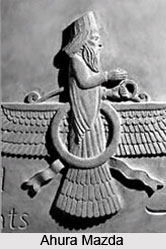 Ahura Mazda is the Avestan (proto-Indo-Iranian language) term, Ahura stands for "right divinities and opposed to the daeves - the wrong divinities. Mazda is generally taken to be the name of the deity and like the Sanskrit term "medha" means intelligence or wisdom. Therefore Ahura Mazda stands for Wise Lord or Lord of Wisdom. Ahura Mazda is the Supreme god of Zoroastrians (who today call themselves Parsi`s) the religion that has its origins in the preaching of Zarathustra around 600 B.C . The pictorial description of Ahura Mazda is shown with a beard on a winged disk. It is believed that Ahura Mazda is the father of two twin spirits, Spenta Mainyu and Angra Mainyu. While the former is the holy spirit, the latter also known as Ahriman is the destructive one In the ancient times it was believed that Ahura Mazda had created heaven and earth, the social structures and also the protector of kings and all righteous people. Zarathustra selected Ahura Mazda from the other deities, positioning him in an elevated status and the dualism of early Zoroastrianism changed to monotheism in which existence is credited to one god alone.
Ahura Mazda is the Avestan (proto-Indo-Iranian language) term, Ahura stands for "right divinities and opposed to the daeves - the wrong divinities. Mazda is generally taken to be the name of the deity and like the Sanskrit term "medha" means intelligence or wisdom. Therefore Ahura Mazda stands for Wise Lord or Lord of Wisdom. Ahura Mazda is the Supreme god of Zoroastrians (who today call themselves Parsi`s) the religion that has its origins in the preaching of Zarathustra around 600 B.C . The pictorial description of Ahura Mazda is shown with a beard on a winged disk. It is believed that Ahura Mazda is the father of two twin spirits, Spenta Mainyu and Angra Mainyu. While the former is the holy spirit, the latter also known as Ahriman is the destructive one In the ancient times it was believed that Ahura Mazda had created heaven and earth, the social structures and also the protector of kings and all righteous people. Zarathustra selected Ahura Mazda from the other deities, positioning him in an elevated status and the dualism of early Zoroastrianism changed to monotheism in which existence is credited to one god alone.
Ahura Mazda is the god of prophetic revelation and associated with truth and righteousness. He bestowed fire on his followers, which is conceived to be the symbol of truth. Quite ideally therefore in fire-temples the divine flame of the fire burns perpetually to indicate his presence. Since Ahura Mazda is held to be the creator of all physical creations and all creations ran according to the master plan of Ahura Mazda, it is the very violations of the order, which therefore acts as the violations against creations both visible and invisible. He is unapproachable and invisible because of his holiness and therefore his contact with prophets were always through mediatory attributes called Amesha Spentas.




















